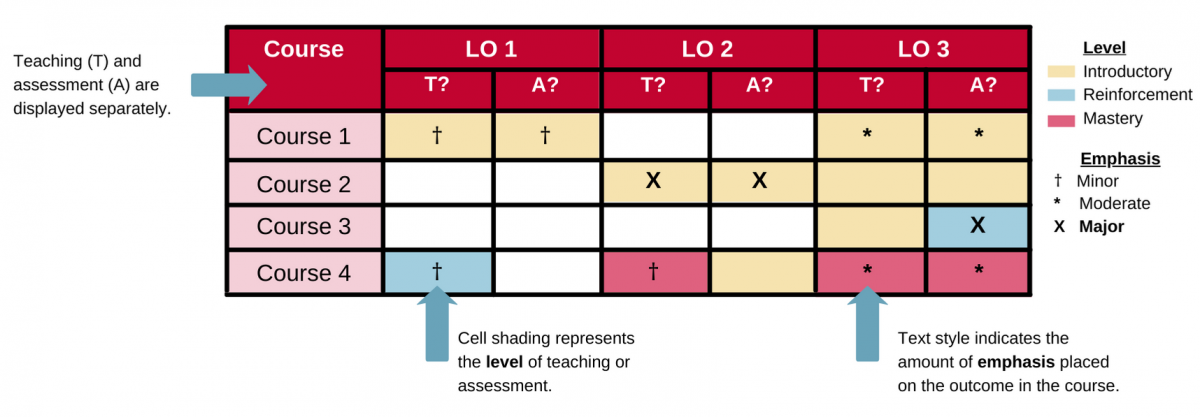Curriculum Mapping
A curriculum map provides a visual representation of the extent to which courses within a program or degree teach and assess learning outcomes or competencies required for graduates.
A Simplified Curriculum Map

A Curriculum Map Containing Additional Information

Considerations When Reviewing A Curriculum Map
- Curriculum maps show a snapshot of a program at one time.
- Expect to revise curriculum maps as the program changes over time.
- Courses are designed to work together to deliver the program learning outcomes or competencies.
- All courses do not need to cover all outcomes.
- Consider the information contained in a curriculum map as one source of data.
- Review other information including student feedback, course outlines, and instructor reflections to gain a fuller picture of the curriculum.
- Use curriculum maps to guide reflections and discussions.
- Curriculum mapping data must be interpreted to be useful.
Questions to Consider When Reviewing a Program Curriculum Map
- Are there gaps in the coverage (i.e., teaching and/or assessment) of any of the outcomes?
- Do students have the opportunity to reach Mastery level for all program outcomes?
- Are outcomes that are taught also assessed, and vice-versa?
- Are any of the outcomes overemphasized or unnecessarily repeated?
- Is this repetition intended for student learning, or can the outcome be streamlined?
- Are there any unintended redundancies?
- Is the same level of expectation of an outcome repeated over and over unnecessarily?
- Does the sequencing of courses allow students to progress through the outcomes?
- Do outcomes flow from Introduction to Reinforcement to Mastery?
- Are all outcomes covered in the program’s required courses?
- If some outcomes are only covered in the elective courses, consider how you ensure that all students have the opportunity to achieve the outcomes.
Questions to Consider When Reviewing A Curriculum Map for an Individual Course
- Does the course cover (i.e., teach and assess) appropriate and logical outcomes based on the course description, course level, etc.?
- Does the course cover outcomes at an appropriate level?
- Are students expected to achieve Mastery in their first year?
- Are new concepts Introduced in a final year course?
- Is the degree of emphasis placed on an outcome appropriate for the course based on the course description, course level, emphasis in other courses, etc.?
- Are there any outcomes that the course should cover that it does not?
- Are there any outcomes that the course does cover that it should not?
- Does the course cover outcomes that are not addressed elsewhere in the program?
- Does this course play a key role in covering an outcome that students would not be taught or assessed if not for this course? If so, is the course required for all students?
Additional Resources
Curriculum mapping. Office of the Associate Vice-President Academic, University of Guelph. https://www.uoguelph.ca/vpacademic/avpa/outcomes/curriculummap.php
Stewart, C., & Kustra, E. (2018). Program curriculum mapping and analysis guide. Centre for Teaching and Learning, University of Windsor. https://www.uwindsor.ca/ctl/sites/uwindsor.ca.ctl/files/program-curriculum-mapping-and-analysis-guide2.pdf